Bob Dylan
Tempo
A Rowman & Littlefield Music Series
on Rock, Pop, and Culture
Series Editor: Scott Calhoun
Tempo: A Rowman & Littlefield Music Series on Rock, Pop, and Culture offers titles that explore rock and popular music through the lens of social and cultural history, revealing the dynamic relationship between musicians, music, and their milieu. Like other major art forms, rock and pop music comment on their cultural, political, and even economic situation, reflecting the technological advances, psychological concerns, religious feelings, and artistic trends of their times. Contributions to the Tempo series are the ideal introduction to major pop and rock artists and genres.
Bon Jovi: Americas Ultimate Band, by Margaret Olson
Bob Dylan: American Troubadour, by Donald Brown
Ska: The Rhythm of Liberation, by Heather Augustyn
Bruce Springsteen: American Poet and Prophet, by Donald L. Deardorff II
American Troubadour
Donald Brown
ROWMAN & LITTLEFIELD
Lanham Boulder New York Toronto Plymouth, UK
Published by Rowman & Littlefield
4501 Forbes Boulevard, Suite 200, Lanham, Maryland 20706
www.rowman.com
10 Thornbury Road, Plymouth PL6 7PP, United Kingdom
Copyright 2014 by Donald Brown
All rights reserved. No part of this book may be reproduced in any form or by any electronic or mechanical means, including information storage and retrieval systems, without written permission from the publisher, except by a reviewer who may quote passages in a review.
British Library Cataloguing in Publication Information Available
Library of Congress Cataloging-in-Publication Data
Brown, Donald, 1959 author.
Bob Dylan : American troubadour / Donald Brown.
pages cm. (Tempo : a Rowman & Littlefield music series on rock, pop, and culture)
Includes bibliographical references and index.
ISBN 978-0-8108-8420-5 (cloth : alk. paper) ISBN 978-0-8108-8421-2 (electronic)
1. Dylan, Bob, 1941Criticism and interpretation. 2. Dylan, Bob, 1941Influence. I. Title.
ML420.D98B77 2014
782.42164092dc23
[B]
2013044394
 TM The paper used in this publication meets the minimum requirements of American National Standard for Information Sciences Permanence of Paper for Printed Library Materials, ANSI/NISO Z39.48-1992.
TM The paper used in this publication meets the minimum requirements of American National Standard for Information Sciences Permanence of Paper for Printed Library Materials, ANSI/NISO Z39.48-1992.
Printed in the United States of America
In memory of my mom, Elaine Taylor Brown,
and my dad, Fred Earl Brown
For Kajsa
Series Editors Foreword
For a book series such as this, which examines popular and rock music within the cultural context of its time, one could not find a better case study than the American musician Bob Dylan. Born into the first generation of rock and rollers, he has marked time with his changing times since his first public performance in 1960. Every few years since then, there have been new songs, new albums, and new live performances, up through the publication of this volume, all of which have drawn their strength from the swirling forces of change Dylan has sought to bear witness to. His music often critiques forms of complacency and intolerance without mentioning a social ill or an institutional abuse by name. But because he first appeared in Greenwich Village at the start of the 1960s and melted right into the spirit of those timesa decade when protest was the conspicuous function of folk and rock musicmany felt Dylan was their sympathizer. With each new offering, fans and critics alike have approached the singer-songwriter of Americana, that mixture of folk, roots, blues-rock, Western swing, and country, looking for a Jesus but sometimes meeting a Judas. Generally, though, Dylan has won everyone over for being both.
We would do well to remember that while Robert Allen Zimmerman was born in 1941, Bob Dylan didnt exist until 1960, and he didnt invent himself to be our friend. As a product of changing times, Dylan has embodied the constant of change and has offered us a commentary on the human experience by developing into one of the most enigmatic public performers in the history of American popular music. Once or twice a decade he has re-formed himself; or rather, he has revealed a new side of Bob Dylan the searching poet of the restless self. Keeping in mind that Bob Dylan is an invention crystallizes the fact (or is it a myth?) that Americans are as much inventions unfolding over time as they are a people connected to a place. In Dylans search and out of his own unease has arisen a defiant spirit, fueling him to challenge cultural conventions and his fans expectations of what Bob Dylan should do or who he should be. His particular defiance, as an expression of living the American Experience, can be heard in the dialect of snarl. As prolific as Walt Whitman, but with a lot less of that American bards love for the self and optimism for mankind, Dylan sings the conflicted body electric. His has mastered this form of the American voice and his fluency has never been better expressed than in his now iconic question: How does it feel / To be on your own / With no direction home / Like a complete unknown / Like a rolling stone? In this question Dylan concedes the blessing and curse of America. Here, there is freedom to invent oneself and set out on your own; but here, you will live alone as you follow the long, frustrating path of turning dreams into lesser forms of reality. Dylan has clearly enjoyed the artists freedom to create himself and explore his medium, but he declaims those who rest in America as though this is the promised land. Judging by the frequency with which Dylan himself adopts this perspective, one wonders if its the voice he finds the most comfort in, too. Many listeners, however, like this side of Dylan and seem to revel in his Old Testamentprophet persona. Misery does love company.
But the trap of studying Bob Dylan as a cultural symbol, a seething-sage, or a cipher for the changing times he appears to be singing about is in listening to his work only for specific comment on the correspondingly specific modern dilemmas he seems to link himself to. As good a study as he is for hearing the decline of a cohesive cultural narrative of hope in postWorld War II America, he is a better poet of the injustice felt in the human heart in any given time or place. Dylan lays the trap himself with a brilliance of familiar and obscure allusions, but if we are not ensnared in the literal lyric, then we find his art assays the timeless longings of the human heart: for an end to suffering; for justice against oppressors; for reward for perseverance; for love that remains.
As a troubadour, Bob Dylan arrives in mystery and includes the material of our lives and our times in his songs. Inasmuch as we think Dylan speaks for us, we think so because we know our times as well as he does; he just helps us realize that we do. In as much as we feel he has an answer to our questions, we do so because he is amplifying what we already feel in our bones or hear blowin in the wind. It turns out that as an American troubadour, Dylan is us, only more so. But while he sings for us, he sings first for himself. He is on a fulltime, singular search for happiness while we typically search in snatches and bursts when we feel we can spare the time. He is as kind, as sincere, and as greedy as we are. He is as dissatisfied as we are with the incompleteness of things. But he spends more time dwelling on it, and then he plays us a song about it. He entertains us by performing the American consciousness, which we dont realize until the song is over and he is gone.

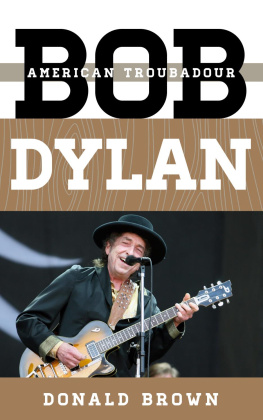

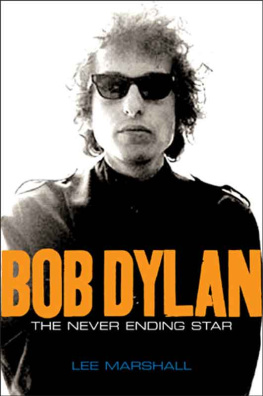
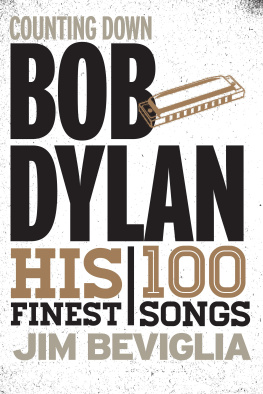
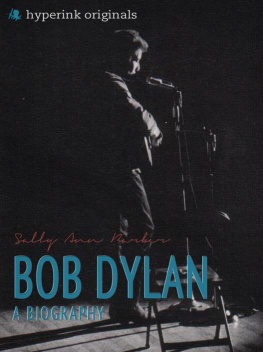

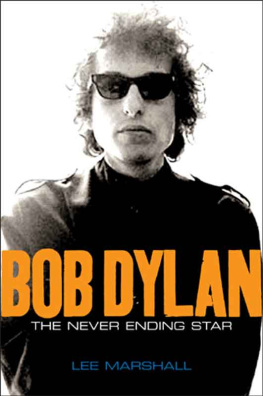
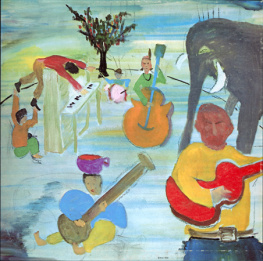
 TM The paper used in this publication meets the minimum requirements of American National Standard for Information Sciences Permanence of Paper for Printed Library Materials, ANSI/NISO Z39.48-1992.
TM The paper used in this publication meets the minimum requirements of American National Standard for Information Sciences Permanence of Paper for Printed Library Materials, ANSI/NISO Z39.48-1992.